Effect of Tuned Spring on Vibration Control Performance of Modified Liquid Column Ball Damper
Abstract
:1. Introduction
2. Mathematical Modelling
2.1. Tuned Liquid Column Ball Spring Damper (TLCBSD)
2.1.1. Tuned Liquid Column Ball Spring Sliding Damper (TLCBSSD)
2.1.2. Tuned Liquid Column Ball Spring Rolling Damper (TLCBSRD)
2.2. Tuned Liquid Column Ball Damper (TLCBD)
3. Parameter Optimization
3.1. Optimization of Tuning Frequency of Liquid Column Ball System
3.2. Optimization of Tuning Frequency of TLCBSD System
4. Results and Discussion
4.1. Response of the Structure Subjected to Harmonic Loading
4.2. Response of the Structure Subjected to Seismic Excitation
4.3. Frequency Domain Response of Structure
4.4. Response of the Structure Subjected to Impulsive Loading
4.5. Design Guidelines for Tunned Liquid Column Ball Spring Damper
- (1)
- Choose the mass ratio for the liquid portion of the damper (0.5% to 5%) [43]. The higher the mass ratio, the better the efficiency of the damper will be.
- (2)
- For economical design, select a length ratio ά in the range of 0.7 to 0.9 [40].
- (3)
- Select an optimum tuning frequency of the liquid column of the damper in the range of 0.96 to 1.04 (Figure 4)
- (4)
- Find the length of the damper using the chosen optimal tuning frequency.
- (5)
- Find the cross-sectional area of the tube using the length and mass ratio.
- (6)
- For optimum results, take the ball–tube diameter ratio = 0.8 [43].
- (7)
- In the case of a TLCSSD, for optimum results choose a tuning frequency for the spring–ball attachment equal to or greater than 1.4.
- (8)
- For a TLCSRD arrangement, select an optimal tuning frequency for the spring–ball attachment equal to or greater than 1.6.
5. Conclusions
Author Contributions
Funding
Institutional Review Board Statement
Informed Consent Statement
Data Availability Statement
Acknowledgments
Conflicts of Interest
Nomenclature
| ms | Mass of the main structure | A | The cross-sectional area of the tube |
| mf | Mass of the fluid | Ab | The cross-sectional area of the ball |
| µ | The ratio of the mass of the fluid to the mass of the structure | The ratio of the horizontal length to the total length of the fluid | |
| Rb | The radius of the ball | deq | Damping due to ball–fluid interaction |
| η | Tuning frequency | Mass moment of inertia of the ball | |
| L | Total liquid length | The density of the fluid | |
| b | Fluid length in horizontal section | h | Undisturbed fluid vertical length |
| Displacement of the main structure | cs | Damping coefficient of the main structure | |
| g | Gravitational acceleration | Damping coefficient of the spring | |
| ks | Primary structure stiffness | The damping ratio of the main structure | |
| kbs | Stiffness of the spring–ball attachment | The damping ratio of the fluid | |
| The natural frequency of the liquid column | The damping ratio of the spring–ball system | ||
| The natural frequency of the main structure | t | Time | |
| The natural frequency of the spring–ball attachment | Ct | Equivalent damping due to fluid–ball interaction | |
| Frequency of the external force | Displacement of the ball | ||
| R | Ball–tube diameter ratio | y | Displacement of the fluid surface |
| Externally applied force | ith generalized forces |
References
- Memon, S.A.; Zain, M.; Zhang, D.; Rehman, S.K.U.; Usman, M.; Lee, D. Emerging trends in the growth of structural systems for tall buildings. J. Struct. Integr. Maint. 2020, 5, 155–170. [Google Scholar] [CrossRef]
- Halis Gunel, M.; Emre Ilgin, H. A proposal for the classification of structural systems of tall buildings. Build. Environ. 2007, 42, 2667–2675. [Google Scholar] [CrossRef]
- Baskaran, A. Wind engineering studies on tall buildings-transitions in research. Build. Environ. 1993, 28, 1–19. [Google Scholar] [CrossRef]
- Zain, M.; Usman, M.; Farooq, S.H.; Mehmood, T. Seismic Vulnerability Assessment of School Buildings in Seismic Zone 4 of Pakistan. Adv. Civ. Eng. 2019, 2019. [Google Scholar] [CrossRef] [Green Version]
- Jafari, M.; Alipour, A. Methodologies to mitigate wind-induced vibration of tall buildings: A state-of-the-art review. J. Build. Eng. 2021, 33, 101582. [Google Scholar] [CrossRef]
- Hafeez, M.A.; Usman, M.; Umer, M.A.; Hanif, A. Recent Progress in Isotropic Magnetorheological Elastomers and Their Properties: A Review. Polymers 2020, 12, 1–37. [Google Scholar]
- Koo, J.H.; Jang, D.D.; Usman, M.; Jung, H.J. A feasibility study on smart base isolation systems using magneto-rheological elastomers. Struct. Eng. Mech. 2009, 32, 755–770. [Google Scholar] [CrossRef]
- Khan, B.L.; Azeem, M.; Usman, M.; Farooq, S.H.; Hanif, A.; Fawad, M. Effect of near and far Field Earthquakes on performance of various base isolation systems. Procedia Struct. Integr. 2019, 18, 108–118. [Google Scholar] [CrossRef]
- Tariq, M.A.; Usman, M.; Farooq, S.H.; Ullah, I.; Hanif, A. Investigation of the structural response of the mre-based mdof isolated structure under historic near- and far-fault earthquake loadings. Appl. Sci. 2021, 11, 2876. [Google Scholar] [CrossRef]
- Khayam, S.U.; Usman, M.; Umer, M.A.; Rafique, A. Development and characterization of a novel hybrid magnetorheological elastomer incorporating micro and nano size iron fillers. Mater. Des. 2020, 192. [Google Scholar] [CrossRef]
- Khan, I.U.; Usman, M.; Tanveer, M. Vibration control of an irregular structure using single and multiple tuned mass dampers. Proc. Inst. Civ. Eng.—Struct. Build. 2021, 12, 1–26. [Google Scholar] [CrossRef]
- Ikeda, Y.; Sasaki, K.; Sakamoto, M.; Kobori, T. Active mass driver system as the first application of active structural control. Earthq. Eng. Struct. Dyn. 2001, 30, 1575–1595. [Google Scholar] [CrossRef]
- Xu, Z.; Guo, Y. Integrated intelligent control analysis on semi-active structures by using magnetorheological dampers. Sci. China Ser. E Technol. Sci. 2008, 51, 2280–2294. [Google Scholar] [CrossRef]
- Park, W.; Park, K.-S.; Koh, H.-M. Active control of large structures using a bilinear pole-shifting transform with H∞ control method. Eng. Struct. 2008, 30, 3336–3344. [Google Scholar] [CrossRef]
- Kim, H.-S. Multi-input Multi-output Semi-active Fuzzy Control of Seismicexcited Building with Evolutionary Optimization Algorithms. Int. J. Control Autom. 2014, 7, 143–152. [Google Scholar] [CrossRef]
- Symans, M.D.; Constantinou, M.C. Semi-active control systems for seismic protection of structures: A state-of-the-art review. Eng. Struct. 1999, 21, 469–487. [Google Scholar] [CrossRef]
- Preumont, A. Vibration Control of Active Structures: An Introduction; Springer: Berlin/Heidelberg, Germany, 2011; Volume 246, pp. 403–416. [Google Scholar] [CrossRef]
- Braz-César, M.; Carneiro De Barros, R. Passive Control of Civil Engineering Structures. In Proceedings of the 4th International Conference on Integrity, Reliability and Failure of Mechanical Systems, Funchal, Portugal, 23–27 June 2013; Volume 1, pp. 1–12. [Google Scholar]
- Zhang, M.; Xu, F. Tuned mass damper for self-excited vibration control: Optimization involving nonlinear aeroelastic effect. J. Wind Eng. Ind. Aerodyn. 2022, 220, 104836. [Google Scholar] [CrossRef]
- Bauer, H.F. Oscillations of immiscible liquids in a rectangular container: A new damper for excited structures. J. Sound Vib. 1984, 93, 117–133. [Google Scholar] [CrossRef]
- Haskett, T.; Breukelman, B.; Robinson, J.; Kottelenberg, J. Tuned Mass Dampers under Excessive Structural Excitation; Report of the Motioneering Inc.: Guelph, ON, Canada, 2004. [Google Scholar]
- Di Matteo, A.; Pirrotta, A.; Tumminelli, S. Combining TMD and TLCD: Analytical and experimental studies. J. Wind Eng. Ind. Aerodyn. 2017, 167, 101–113. [Google Scholar] [CrossRef]
- Sakai, F. Tuned liquid column damper-new type device for suppression of building vibration. In Proceedings of the 1st International Conference on High-rise Buildings, Beijing, China, 1989; pp. 926–931. Available online: http://ci.nii.ac.jp/naid/10007252264/en/ (accessed on 22 April 2021).
- Koh, C.G.; Mahatma, S.; Wang, C.M. Theoretical and experimental studies on rectangular liquid dampers under arbitrary excitations. Earthq. Eng. Struct. Dyn. 1994, 23, 17–31. [Google Scholar] [CrossRef]
- Sun, L.M.; Fujino, Y.; Koga, K. A model of tuned liquid damper for suppressing pitching motions of structures. Earthq. Eng. Struct. Dyn. 1995, 24, 625–636. [Google Scholar] [CrossRef]
- Fujino, Y.; Sun, L.; Pacheco, B.M.; Chaiseri, P. Tuned liquid damper (TLD) for suppressing horizontal motion of structures. J. Eng. Mech. 1992, 118, 2017–2030. [Google Scholar] [CrossRef] [Green Version]
- Xue, S.D.; Ko, J.M.; Xu, Y.L. Optimum parameters of tuned liquid column damper for suppressing pitching vibration of an undamped structure. J. Sound Vib. 2000, 235, 639–653. [Google Scholar] [CrossRef]
- Yalla, S.K.; Kareem, A. Optimum absorber parameters for tuned liquid column dampers. J. Struct. Eng. N. Y. 2000, 126, 906–915. [Google Scholar] [CrossRef]
- Chen, J.-L.; Georgakis, C.T. Spherical tuned liquid damper for vibration control in wind turbines. JVC/J. Vib. Control 2015, 21, 1875–1885. [Google Scholar] [CrossRef]
- Ghosh, A.; Basu, B. Seismic vibration control of short period structures using the liquid column damper. Eng. Struct. 2004, 26, 1905–1913. [Google Scholar] [CrossRef]
- Colwell, S.; Basu, B. Investigations on the performance of a liquid column damper (LCD) with different orifice diameter ratios. Can. J. Civ. Eng. 2011, 33, 588–595. [Google Scholar] [CrossRef]
- Hitchcock, P.A.; Kwok, K.C.S.; Watkins, R.D.; Samali, B. Characteristics of liquid column vibration absorbers (LCVA)—I. Eng. Struct. 1997, 19, 126–134. [Google Scholar] [CrossRef]
- Hitchcock, P.A.; Kwok, K.C.S.; Watkins, R.D.; Samali, B. Characteristics of liquid column vibration absorbers (LCVA)—II. Eng. Struct. 1997, 19, 135–144. [Google Scholar] [CrossRef]
- Chang, C.C.; Hsu, C.T. Control performance of liquid column vibration absorbers. Eng. Struct. 1998, 20, 580–586. [Google Scholar] [CrossRef]
- Gao, H.; Kwok, K.C.S.; Samali, B. Optimization of tuned liquid column dampers. Eng. Struct. 1997, 19, 476–486. [Google Scholar] [CrossRef]
- Huo, L.; Li, H. 13 th World Conference on Earthquake Engineering TORSIONALLY COUPLED RESPONSE CONTROL OF STRUCTURES. In Proceedings of the 13th World Conference on Earthquake Engineering, Vancouver, BC, Canada, 1–6 August 2004. [Google Scholar]
- Das, S.; Choudhury, S. Seismic response control by tuned liquid dampers for low-rise RC frame buildings. Aust. J. Struct. Eng. 2017, 18, 135–145. [Google Scholar] [CrossRef]
- Xin, Y.; Chen, G.; Lou, M. Seismic response control with density-variable tuned liquid dampers. Earthq. Eng. Eng. Vib. 2009, 8, 537–546. [Google Scholar] [CrossRef]
- Debbarma, R.; Chakraborty, S.; Kumar Ghosh, S. Optimum design of tuned liquid column dampers under stochastic earthquake load considering uncertain bounded system parameters. Int. J. Mech. Sci. 2010, 52, 1385–1393. [Google Scholar] [CrossRef]
- Shum, K.M. Closed form optimal solution of a tuned liquid column damper for suppressing harmonic vibration of structures. Eng. Struct. 2009, 31, 84–92. [Google Scholar] [CrossRef]
- Wu, J.C.; Shih, M.H.; Lin, Y.Y.; Shen, Y.C. Design guidelines for tuned liquid column damper for structures responding to wind. Eng. Struct. 2005, 27, 1893–1905. [Google Scholar] [CrossRef]
- Shum, K.M.; Xu, Y.L.; Guo, W.H. Wind-induced vibration control of long span cable-stayed bridges using multiple pressurized tuned liquid column dampers. J. Wind Eng. Ind. Aerodyn. 2008, 96, 166–192. [Google Scholar] [CrossRef]
- Al-Saif, K.A.; Aldakkan, K.A.; Foda, M.A. Modified liquid column damper for vibration control of structures. Int. J. Mech. Sci. 2011, 53, 505–512. [Google Scholar] [CrossRef]
- Tanveer, M.; Usman, M.; Khan, I.U.; Ahmad, S.; Hanif, A.; Farooq, S.H. Application of tuned liquid column ball damper (TLCBD) for improved vibration control performance of multi-storey structure. PLoS ONE 2019, 14, 1–15. [Google Scholar] [CrossRef] [PubMed]
- Tanveer, M.; Usman, M.; Khan, I.U.; Farooq, S.H.; Hanif, A. Material optimization of tuned liquid column ball damper (TLCBD) for the vibration control of multi-storey structure using various liquid and ball densities. J. Build. Eng. 2020, 32, 101742. [Google Scholar] [CrossRef]
- Gur, S.; Roy, K.; Mishra, S.K. Tuned liquid column ball damper for seismic vibration control. Struct. Control Health Monit. 2015, 22, 1325–1342. [Google Scholar] [CrossRef]
- Pal, S.; Roy, B.K.; Choudhury, S. Comparative performance study of tuned liquid column ball damper for excessive liquid displacement on response reduction of structure. Int. J. Eng. Trans. B Appl. 2020, 33, 753–759. [Google Scholar] [CrossRef]
- Shah, M.U.; Usman, M. Feasibility Study of Liquid Tuned Column Hollow Ball Damper for Vibration Control of Structures. In Proceedings of the 2021 World Congress on Advances in Structural Engineering and Mechanics (ASEM21), GECE, Seoul, Korea, 23–26 August 2021; pp. 1–13. [Google Scholar]
- Streeter, V.L.; Wylie, E.B. Fluid Mechanics, 7th ed.; McGraw-Hill: New York, NY, USA, 1979; ISBN 0070622329. [Google Scholar]
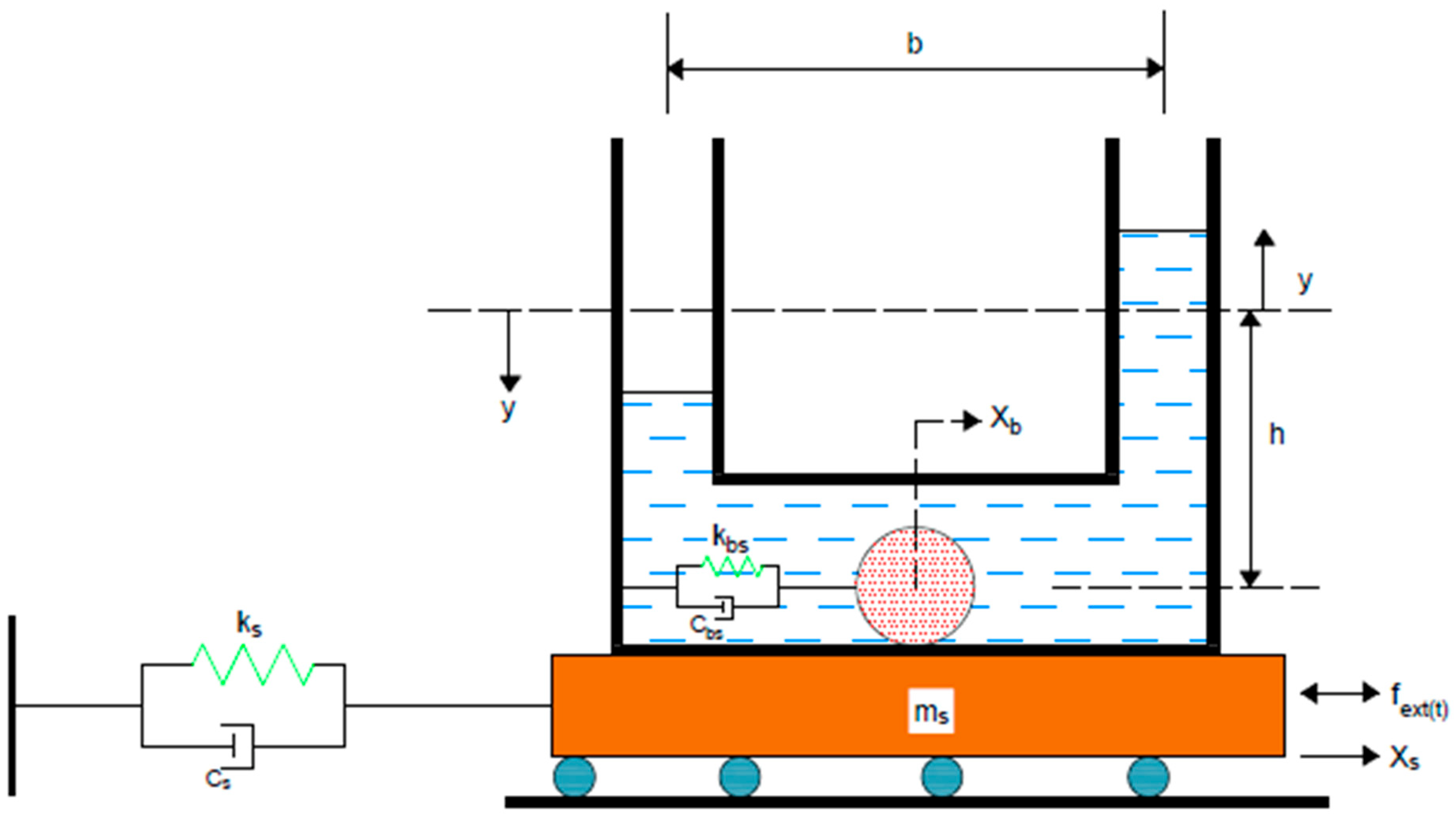
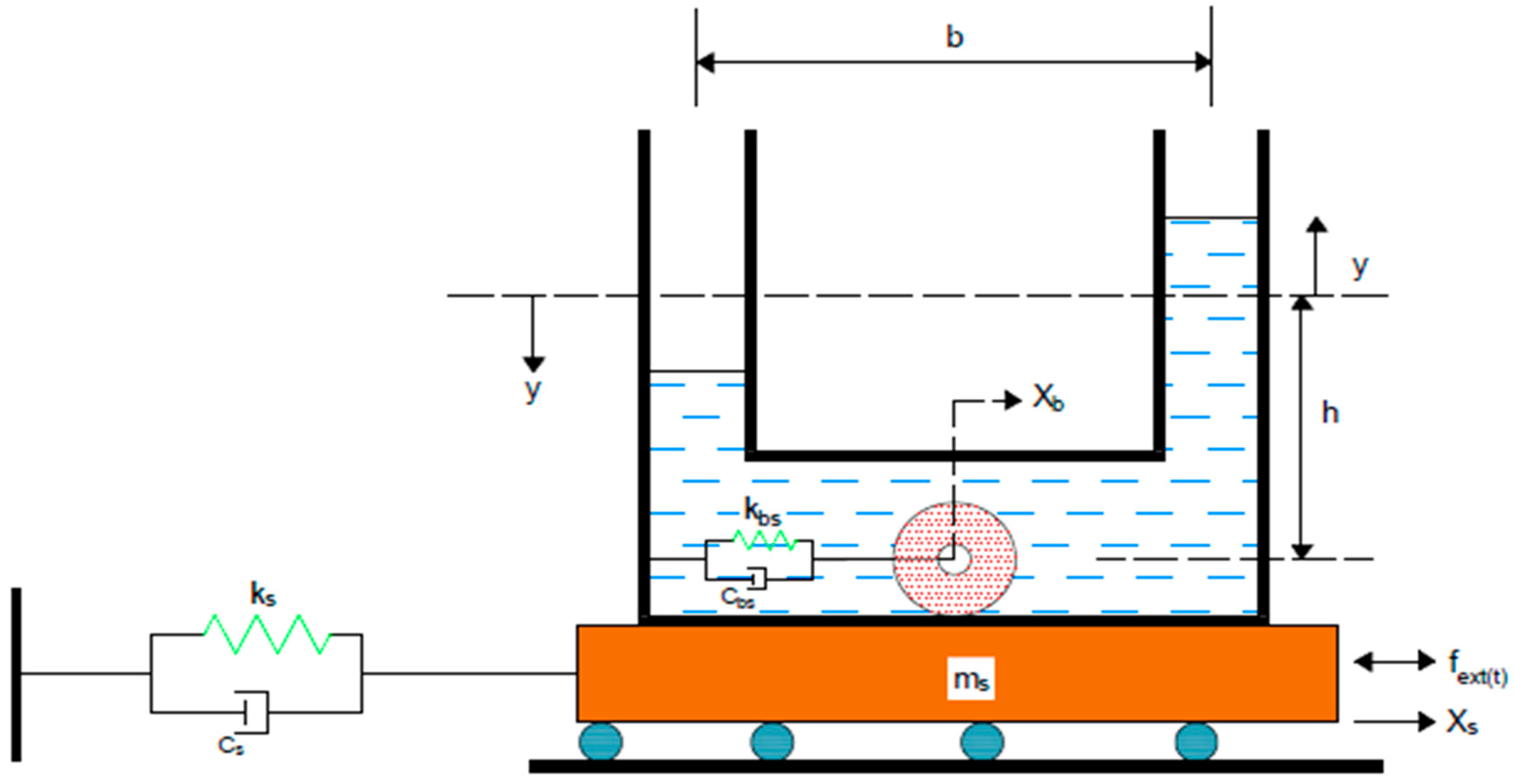
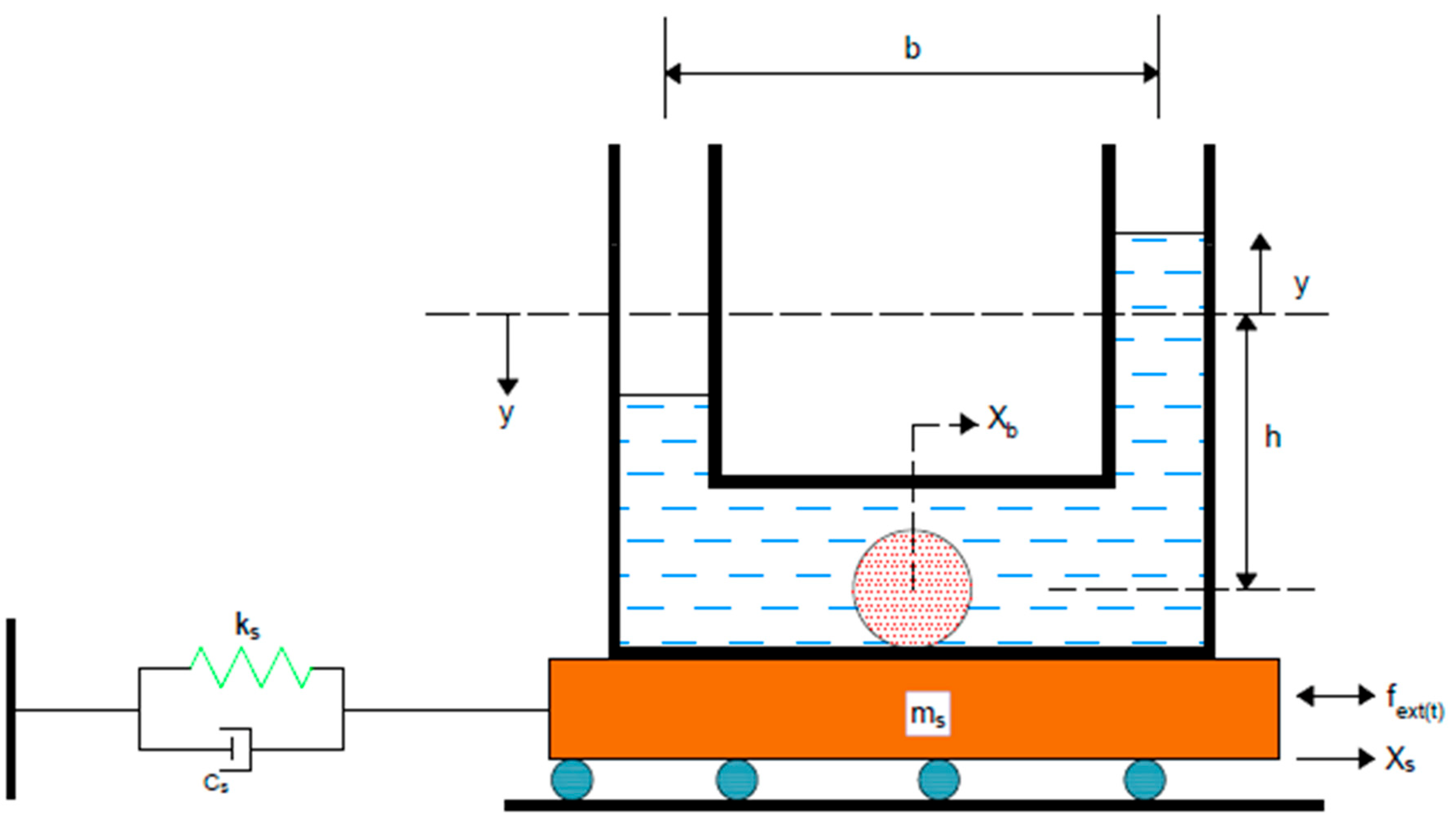
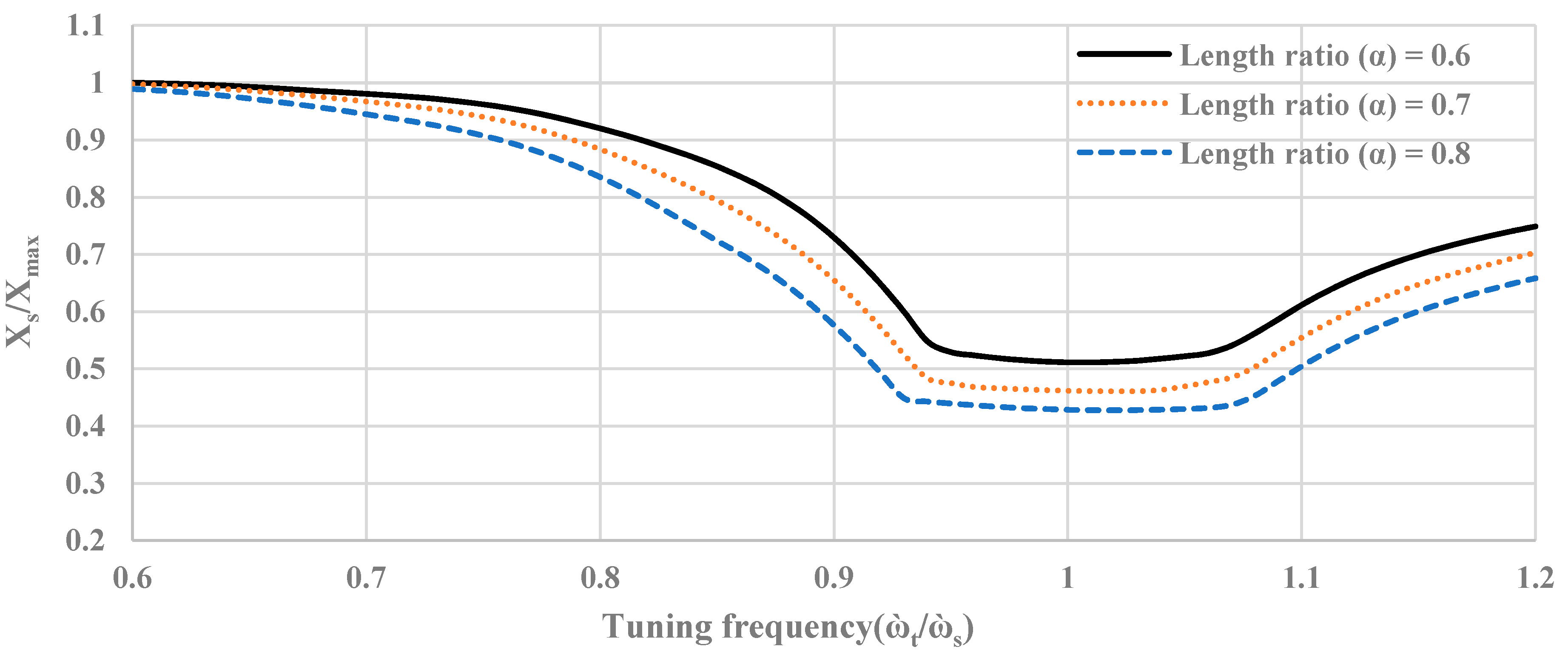
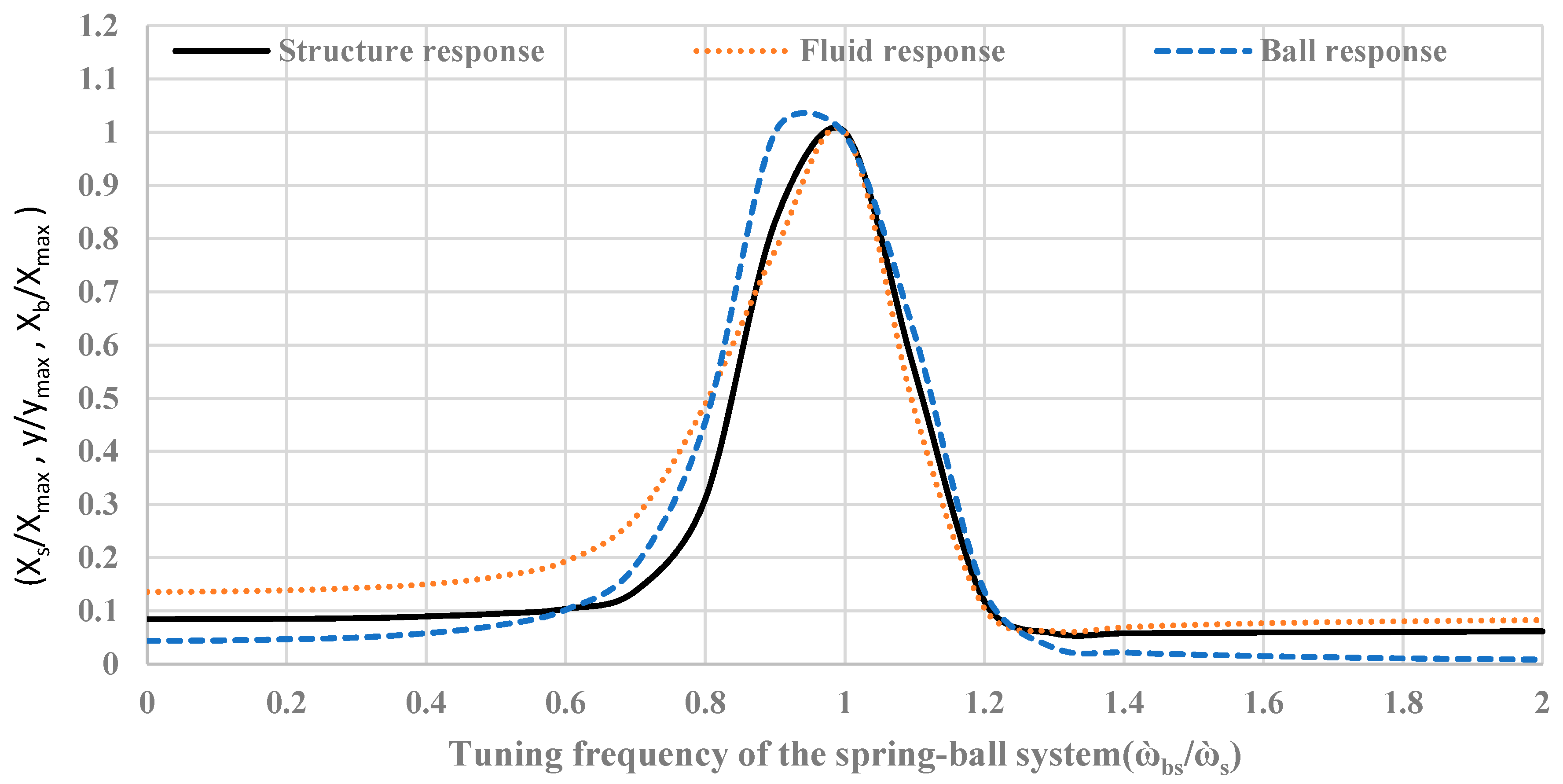
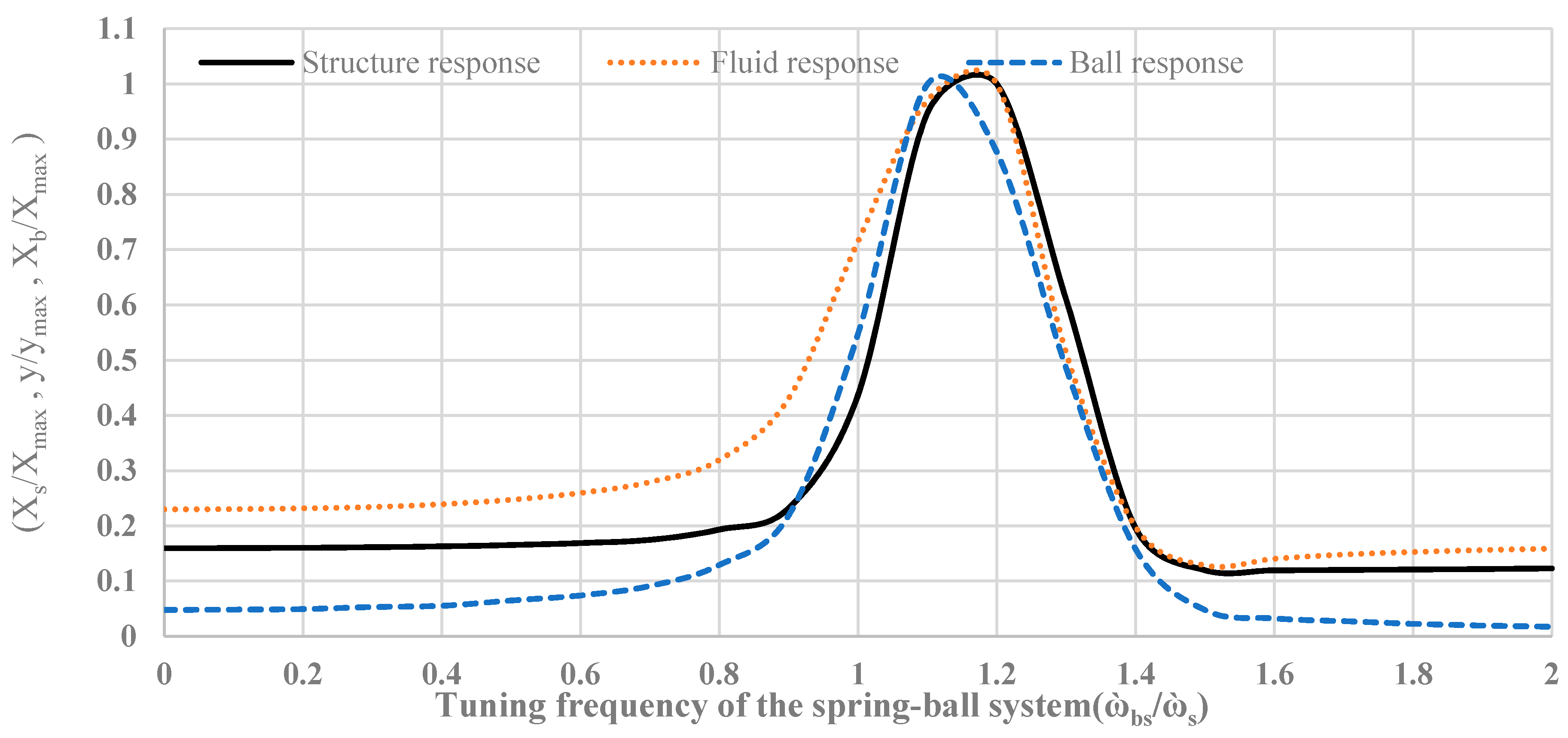
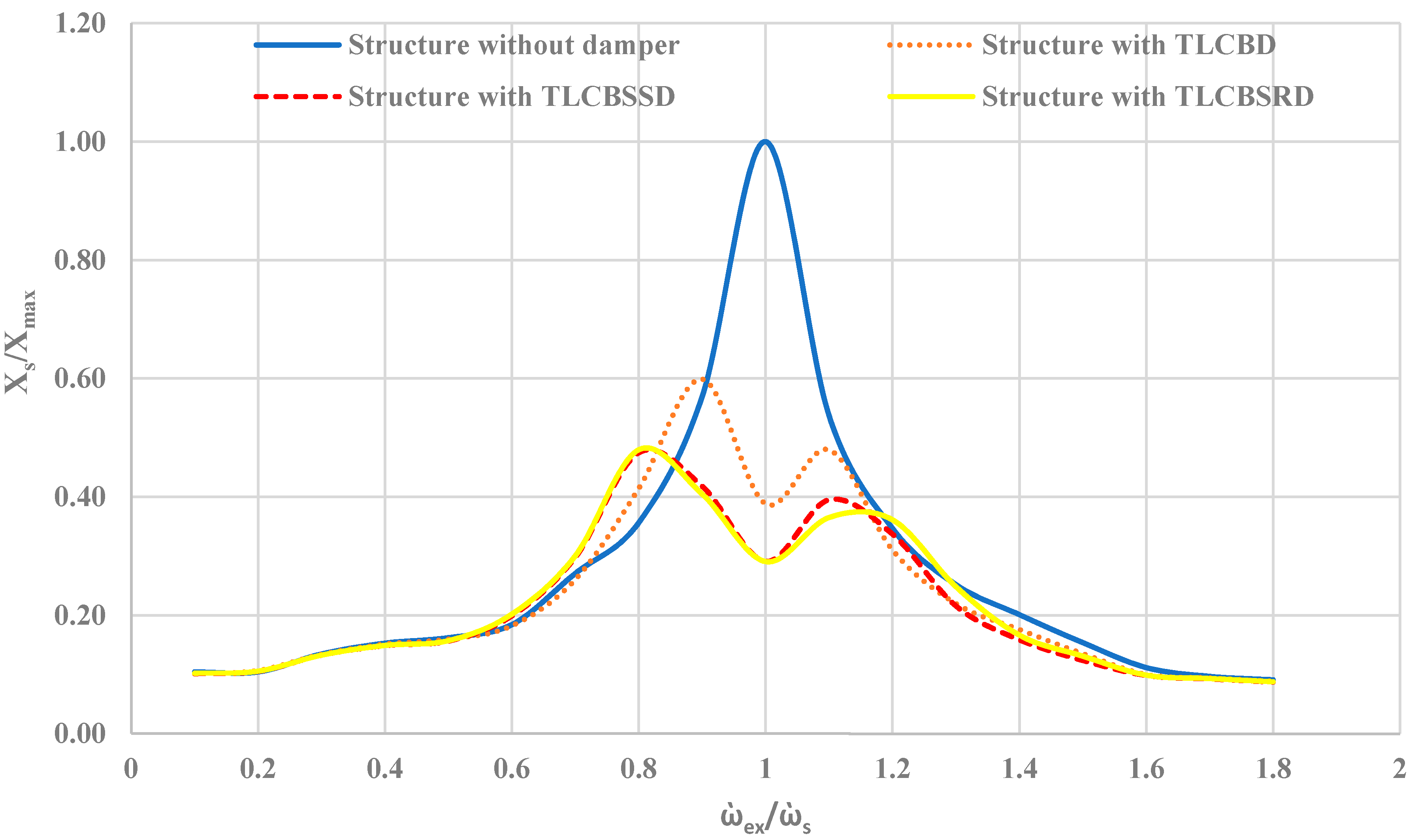
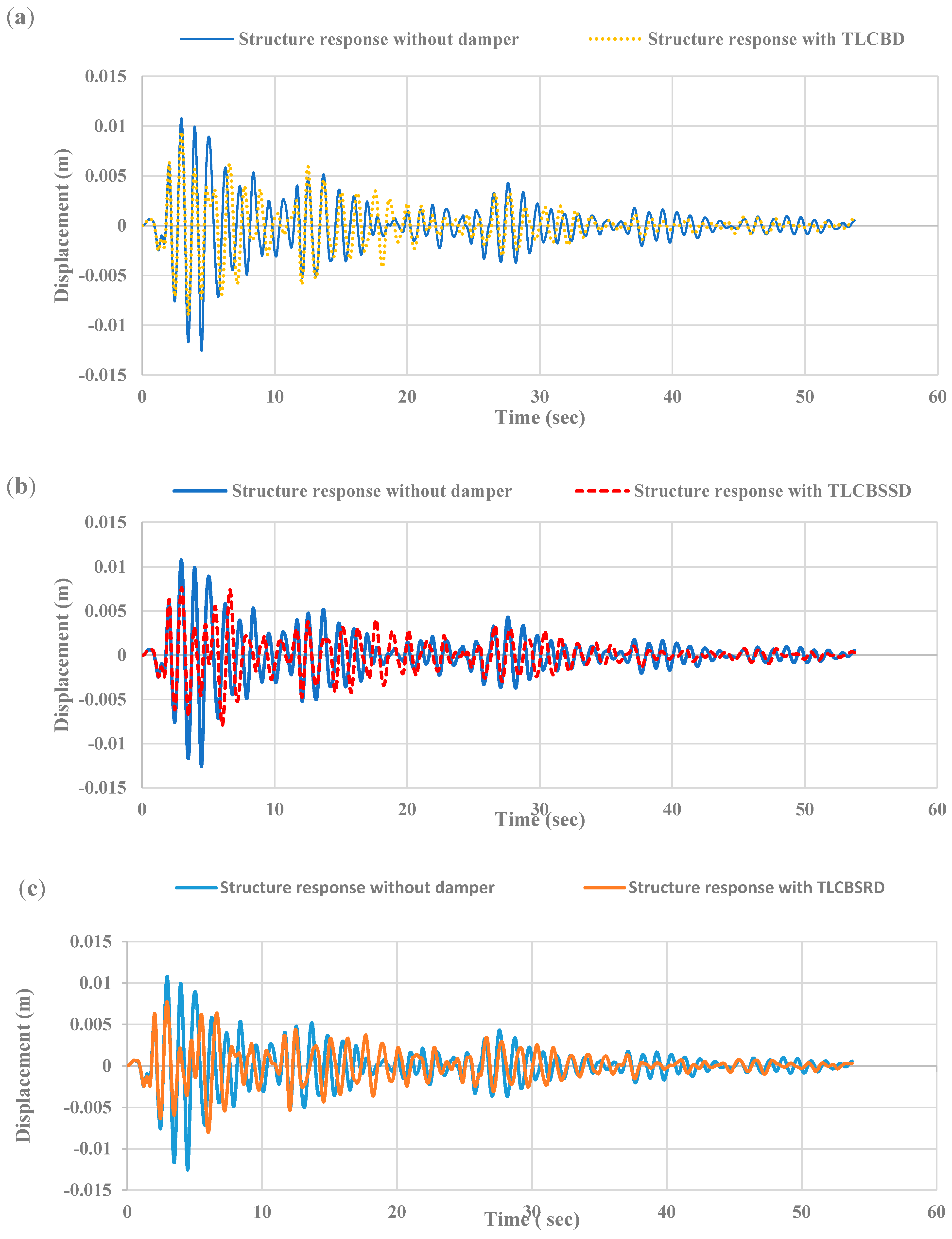
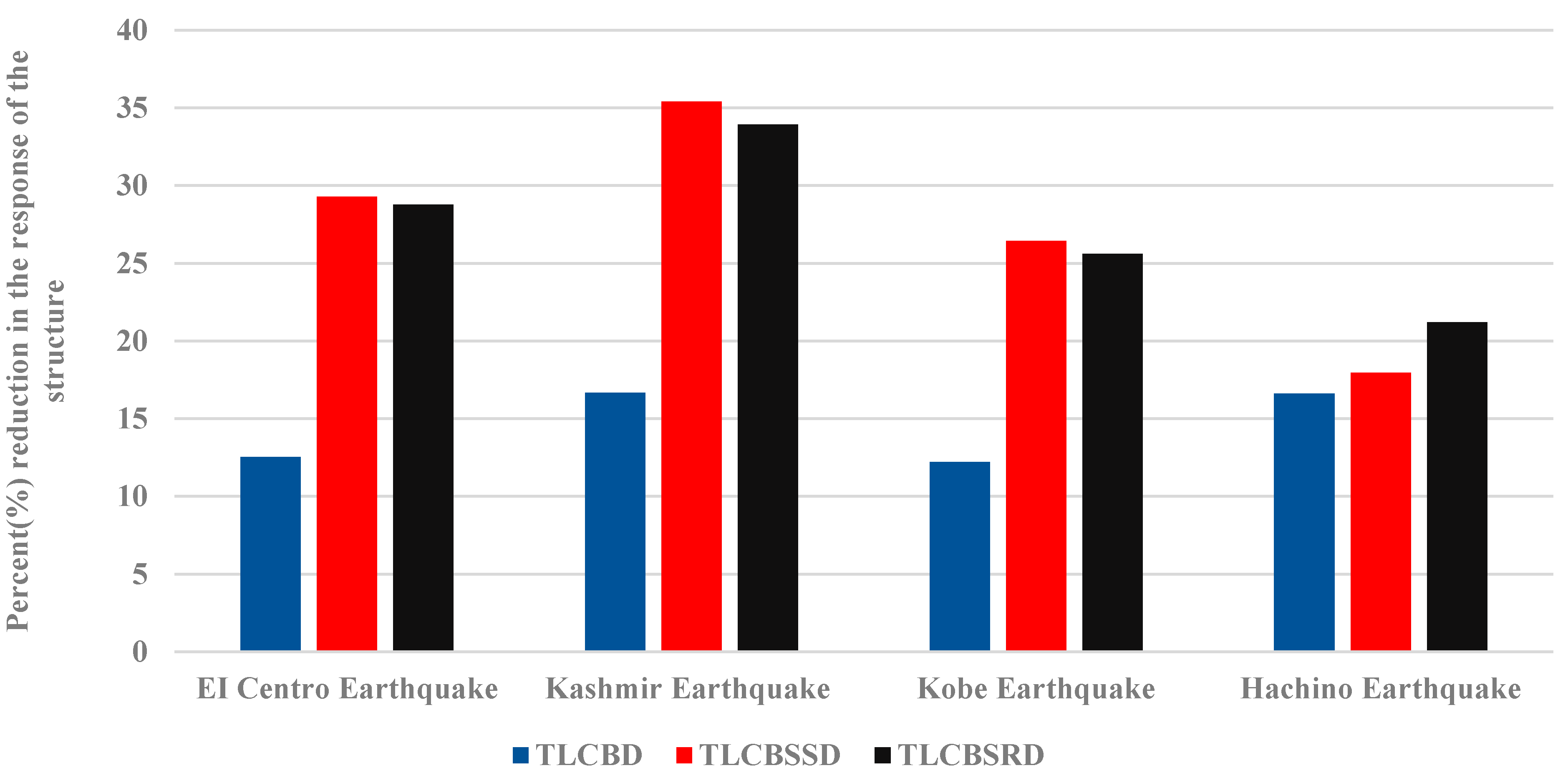
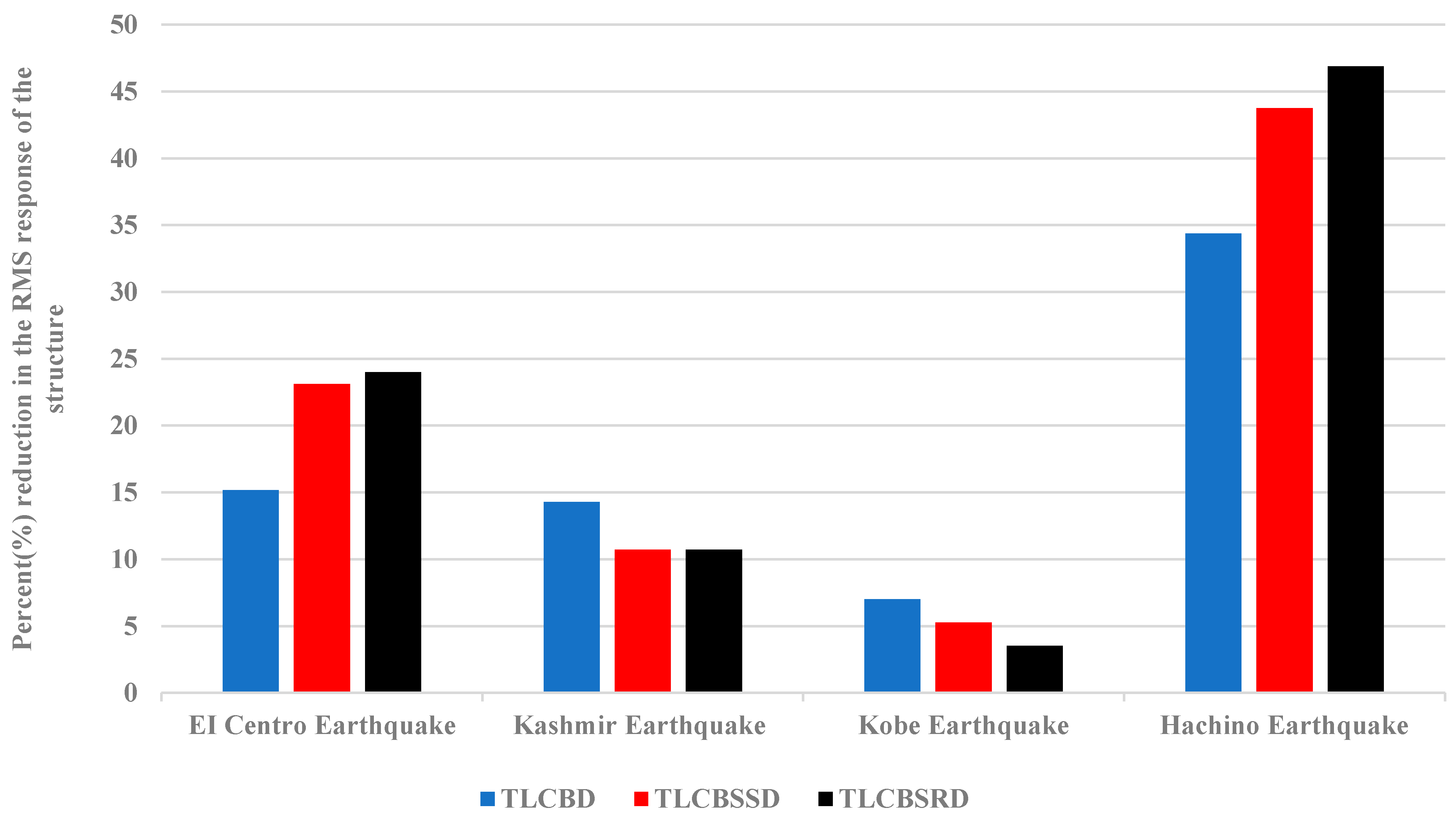


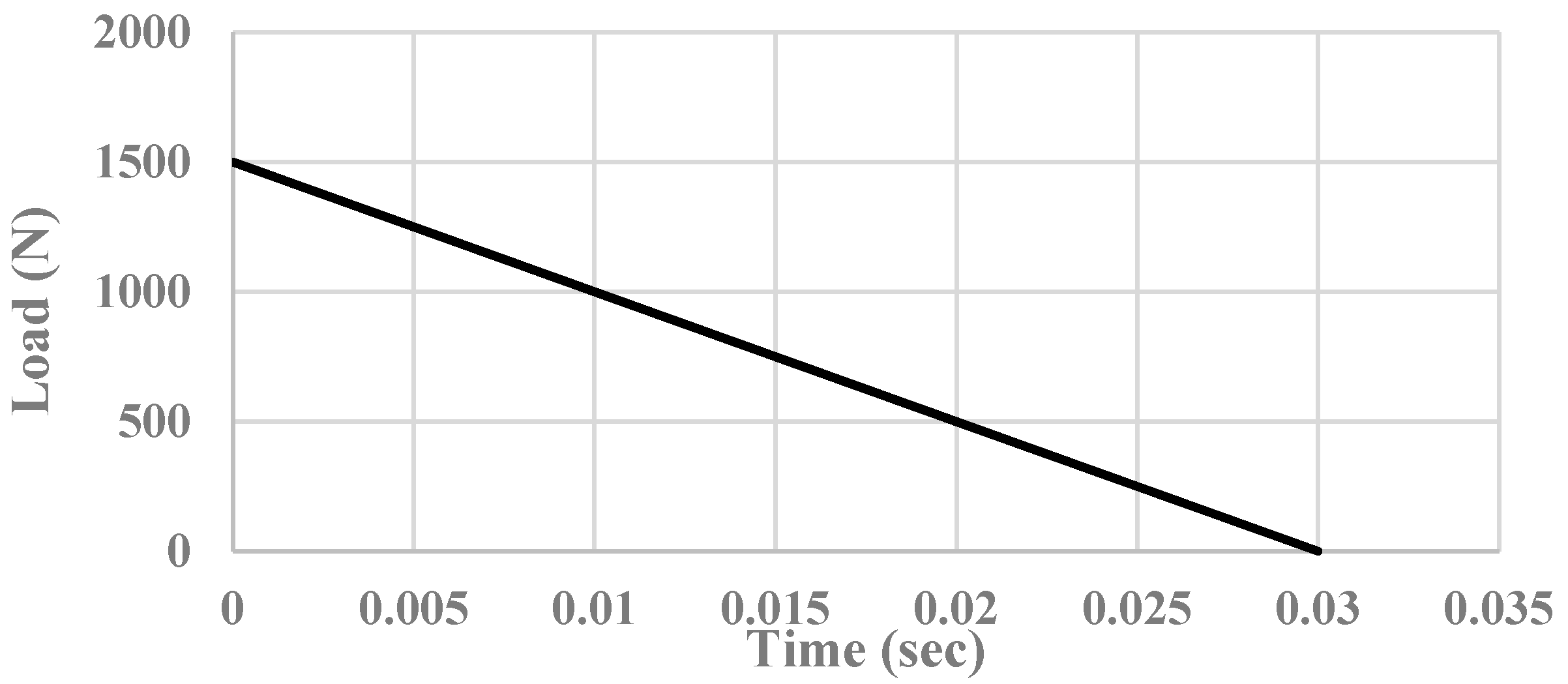


| Parameter | Value |
|---|---|
| Mass ratio, | 0.05 |
| Primary structure fundamental frequency (Hz) | 0.93 |
| The primary structure damping ratio | 0.05 |
| Ball–tube diameter ratio | 0.80 |
| Damping ratio | 0.049 |
| Kinematic viscosity (v) (Nm/s) | 0.001 |
| Tuning Frequency Ratio | Primary Structure Response without Damper | Primary Structure Response with TLCBD at | Primary Structure Response with TLCBD at | Primary Structure Response with TLCBD at | Percent (%) Improvement at | Percent (%) Improvement at | Percent (%) Improvement at |
|---|---|---|---|---|---|---|---|
| 0.90 | 1.00 | 0.71 | 0.63 | 0.56 | 29.49 | 36.70 | 44.31 |
| 0.92 | 1.00 | 0.63 | 0.55 | 0.48 | 37.39 | 44.71 | 52.40 |
| 0.94 | 1.00 | 0.53 | 0.47 | 0.43 | 47.05 | 53.28 | 57.21 |
| 0.96 | 1.00 | 0.51 | 0.45 | 0.42 | 49.39 | 54.73 | 57.83 |
| 0.98 | 1.00 | 0.50 | 0.45 | 0.42 | 50.21 | 55.11 | 58.30 |
| 1.00 | 1.00 | 0.49 | 0.45 | 0.41 | 50.58 | 55.38 | 58.58 |
| 1.02 | 1.00 | 0.50 | 0.45 | 0.41 | 50.49 | 55.45 | 58.68 |
| 1.04 | 1.00 | 0.50 | 0.45 | 0.41 | 49.96 | 55.22 | 58.57 |
| 1.06 | 1.00 | 0.51 | 0.46 | 0.42 | 49.04 | 53.92 | 58.28 |
| Parameter | Value |
|---|---|
| Tuning frequency of the liquid column | 0.98 |
| Length ratio | 0.8 |
| Spring damping ratio | 0.1 |
| Optimum tuning frequency spring-ball system | 1.6 |
| Steel ball, density (kg/m3) | 8050 |
| Structure Response Ratio with TLCBD | Structure Response Ratio with TLCBSSD | Structure Response Ratio with TLCBSRD | Percentage Improvement of TLCBSSD over TLCBD | Percentage Improvement of TLCBSRD over TLCBD | |
|---|---|---|---|---|---|
| 0.90 | 1.00 | 0.70 | 0.68 | 30.35 | 32.44 |
| 0.92 | 0.80 | 0.57 | 0.55 | 28.63 | 31.27 |
| 0.94 | 0.66 | 0.50 | 0.49 | 24.30 | 25.38 |
| 0.96 | 0.66 | 0.50 | 0.49 | 24.93 | 25.52 |
| 0.98 | 0.66 | 0.49 | 0.49 | 25.16 | 25.44 |
| 1.00 | 0.65 | 0.49 | 0.49 | 25.00 | 25.13 |
| 1.02 | 0.64 | 0.48 | 0.48 | 24.50 | 24.63 |
| 1.04 | 0.62 | 0.47 | 0.47 | 24.37 | 23.86 |
| 1.06 | 0.72 | 0.52 | 0.48 | 28.20 | 33.63 |
| 1.08 | 0.79 | 0.59 | 0.55 | 25.32 | 30.35 |
| 1.10 | 0.80 | 0.66 | 0.61 | 17.39 | 23.88 |
Publisher’s Note: MDPI stays neutral with regard to jurisdictional claims in published maps and institutional affiliations. |
© 2021 by the authors. Licensee MDPI, Basel, Switzerland. This article is an open access article distributed under the terms and conditions of the Creative Commons Attribution (CC BY) license (https://creativecommons.org/licenses/by/4.0/).
Share and Cite
Shah, M.U.; Usman, M.; Farooq, S.H.; Kim, I.-H. Effect of Tuned Spring on Vibration Control Performance of Modified Liquid Column Ball Damper. Appl. Sci. 2022, 12, 318. https://doi.org/10.3390/app12010318
Shah MU, Usman M, Farooq SH, Kim I-H. Effect of Tuned Spring on Vibration Control Performance of Modified Liquid Column Ball Damper. Applied Sciences. 2022; 12(1):318. https://doi.org/10.3390/app12010318
Chicago/Turabian StyleShah, Mati Ullah, Muhammad Usman, Syed Hassan Farooq, and In-Ho Kim. 2022. "Effect of Tuned Spring on Vibration Control Performance of Modified Liquid Column Ball Damper" Applied Sciences 12, no. 1: 318. https://doi.org/10.3390/app12010318
APA StyleShah, M. U., Usman, M., Farooq, S. H., & Kim, I.-H. (2022). Effect of Tuned Spring on Vibration Control Performance of Modified Liquid Column Ball Damper. Applied Sciences, 12(1), 318. https://doi.org/10.3390/app12010318








